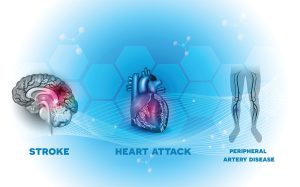
Getting active after a long period of inactivity can cause a bit of a shock to the system. You may notice some cramping in your lower body, as well as other aches and pains.
But not every cramp or pain in the legs is as innocent as growing pains. Sometimes it can be an early signal of a condition called peripheral artery disease, or PAD, and it should be checked by your doctor.
PAD happens when plaque develops in the blood vessels of the extremities and restricts blood flow to the legs and sometimes arms. If left alone to become severe, it can lead to amputation.
Early-stage symptoms are barely noticeable or easily attributable to something else. The first signs of a problem are repeated pain, cramping, or heaviness in one or both legs while walking or exercising. These symptoms happen because muscles aren’t getting oxygen or nutrients.
If allowed to advance, symptoms can become more severe and include wounds or ulcers on the feet that won’t heal. Continuous pain or numbness is also a possibility.
With PAD, the earlier it is identified and treated, the better the outcome is likely to be. Treatments often include dietary changes, exercise, medication, and in some cases, medical procedures.
Genetics plays a role in PAD risk, but 4 of the top 5 risk factors are controllable. Smoking, high blood pressure, high blood sugar, diabetes, and high cholesterol will all boost the risk of PAD but can also be controlled with lifestyle decisions.
Smoking is the biggest risk factor, as PAD is far more prevalent in smokers than non-smokers.
Quitting smoking, getting into a structured exercise program, and eating a healthier diet can all help. If pain persists during exercise, take a rest when needed.
If you’ve been experiencing pain in your legs, talk to your doctor. If they can identify PAD, they can help you develop the best way to treat it.